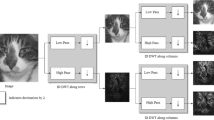Abstract
Single image super resolution (SR) based on sparse representation is a promising technique where the SR problem is solved by searching for the most robust representation of a signal in terms of atoms in a dictionary. However, first and second-order derivatives are always used as features for patches to be trained as dictionaries and super-resolved patches are reconstructed using dictionaries and sparse representation of these features. In this paper, a novel single image SR algorithm based on sparse representation with considering the effect of significant features is proposed. Therefore, high frequency details are preserved using discrete wavelet transform (DWT). In addition, an intermediate process is also proposed to learn finer dictionaries and thereby estimate the sharper and more detailed super-resolved image. The dictionaries are constructed from the distinctive features using K-SVD dictionary learning algorithm. The intermediate process uses approximation subband. Thus, constructed dictionaries contain so much more significant information and the interpolated high frequency components are corrected. Therefore, the intermediate process restores the high frequency details better in super-resolved images. The proposed algorithm was tested on ‘Set14’ dataset. Owing to DWT, the proposed algorithm recovers the edges better as well as improving the computational efficiency. The quantitative and visual results show the superiority and competitiveness of the proposed method over the simplest techniques and state-of-art SR algorithms. Experimental time comparisons with the state-of-art algorithms validate the effectiveness of the proposed approach.







Similar content being viewed by others
References
Aharon M, Elad M, Bruckstein A (2006) K-svd: An algorithm for designing overcomplete dictionaries for sparse representation. IEEE Trans Signal Process 54(11):4311–4322
Babacan SD, Molina R, Katsaggelos AK (2011) Variational bayesian super resolution. IEEE Trans Image Process 20(4):984–999
Chang H, Yeung DY, Xiong Y (2004) Super-resolution through neighbor embedding. In: Proceedings of the 2004 IEEE computer society conference on computer vision and pattern recognition, 2004. CVPR 2004, vol 1. IEEE, pp I–I
Chen SS, Donoho DL, Saunders MA (2001) Atomic decomposition by basis pursuit. SIAM Rev 43(1):129–159
Dai S, Han M, Xu W, Wu Y, Gong Y (2007) Soft edge smoothness prior for alpha channel super resolution. In: IEEE conference on computer vision and pattern recognition, 2007. CVPR’07. IEEE, Piscataway, pp 1–8
Donoho DL, Elad M (2003) Optimally sparse representation in general (nonorthogonal) dictionaries via 1 minimization. Proc Natl Acad Sci 100(5):2197–2202
Freeman WT, Pasztor EC (2000) Carmichael OT Learning low-level vision. Int J Comput Vis 40(1):25–47
Keys RG (1981) Cubic convolution interpolation for digital image processing. IEEE Trans Acoust Speech Signal Process 29(6):1153–1160
Li X, Orchard MT (2001) New edge-directed interpolation. IEEE Trans Image Process 10(10):1521–1527
Mallat SG, Zhang Z (1993) Matching pursuits with time-frequency dictionaries. IEEE Trans Signal Process 41(12):3397–3415
Nasrollahi K, Moeslund TB (2014) Super-resolution: a comprehensive survey. Mach Vis Appl 25(6):1423–1468
Nazzal M, Ozkaramanli H (2015) Wavelet domain dictionary learning-based single image superresolution. SIViP 9(7):1491–1501
Pati YC, Rezaiifar R, Krishnaprasad P (1993) Orthogonal matching pursuit: recursive function approximation with applications to wavelet decomposition. In: 1993 conference record of the twenty-seventh asilomar conference on Signals, systems and computers, 1993. IEEE, Piscataway, pp 40–44
Rubinstein R, Zibulevsky M, Elad M (2008) Efficient implementation of the k-svd algorithm using batch orthogonal matching pursuit. CS Technion 40(8):1–15
Sun J, Zheng NN, Tao H, Shum HY (2003) Image hallucination with primal sketch priors. In: 2003 IEEE computer society conference on computer vision and pattern recognition, 2003. Proceedings, vol 2. IEEE, Piscataway, pp II–729
Villena S, Vega M, Molina R, Katsaggelos AK (2009) Bayesian super-resolution image reconstruction using an 1 prior. In: Proceedings of 6th international symposium on Image and signal processing and analysis, 2009. ISPA 2009. IEEE, Piscataway, pp 152–157
Villena S, Vega M, Babacan SD, Molina R, Katsaggelos AK (2013) Bayesian combination of sparse and non-sparse priors in image super resolution. Digital Signal Process 23(2):530–541
Wang Z, Bovik AC, Sheikh HR, Simoncelli EP (2004) Image quality assessment: from error visibility to structural similarity. IEEE Trans Image Process 13 (4):600–612
Wang S, Zhang L, Liang Y, Pan Q (2012) Semi-coupled dictionary learning with applications to image super-resolution and photo-sketch synthesis. In: 2012 IEEE conference on computer vision and pattern recognition (CVPR) . IEEE, Piscataway, pp 2216–2223
Wu X, Fan J, Xu J, Wang Y (2015) Wavelet domain multidictionary learning for single image super-resolution. Can J Electr Comput Eng 2015:37
Yan C, Zhang Y, Dai F, Wang X, Li L, Dai Q (2014) Parallel deblocking filter for hevc on many-core processor. Electron Lett 50(5):367–368
Yan C, Zhang Y, Dai F, Zhang J, Li L, Dai Q (2014) Efficient parallel hevc intra-prediction on many-core processor. Electron Lett 50(11):805–806
Yan C, Zhang Y, Xu J, Dai F, Li L, Dai Q, Wu F (2014) A highly parallel framework for hevc coding unit partitioning tree decision on many-core processors. IEEE Signal Process Lett 21(5):573–576
Yan C, Zhang Y, Xu J, Dai F, Zhang J, Dai Q, Wu F (2014) Efficient parallel framework for hevc motion estimation on many-core processors. IEEE Trans Circuits Syst Video Technol 24(12):2077–2089
Yang J, Wright J, Huang T, Ma Y (2008) Image super-resolution as sparse representation of raw image patches. In: IEEE conference on Computer vision and pattern recognition, 2008. CVPR 2008. IEEE, Piscataway, pp 1–8
Yang J, Wright J, Huang TS, Ma Y (2010) Image super-resolution via sparse representation. IEEE Trans Image Process 19(11):2861–2873
Zeyde R, Elad M, Protter M (2010) On single image scale-up using sparse-representations. In: Curves and surfaces. Springer, Berlin, pp 711–730
Zhu Z, Guo F, Yu H, Chen C (2014) Fast single image super-resolution via self-example learning and sparse representation. IEEE Trans Multimedia 16(8):2178–2190
Acknowledgements
We would like to thank Nazzal et al. [12] for privately sharing the code of their proposed algorithm.
Author information
Authors and Affiliations
Corresponding author
Rights and permissions
About this article
Cite this article
Ayas, S., Ekinci, M. Single image super resolution based on sparse representation using discrete wavelet transform. Multimed Tools Appl 77, 16685–16698 (2018). https://doi.org/10.1007/s11042-017-5233-5
Received:
Revised:
Accepted:
Published:
Issue Date:
DOI: https://doi.org/10.1007/s11042-017-5233-5




